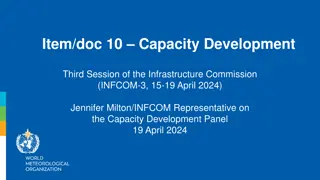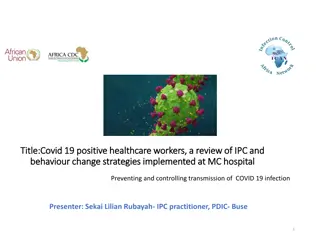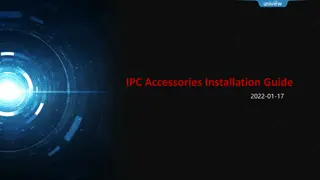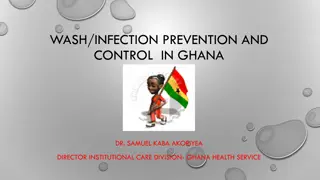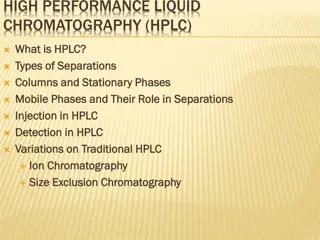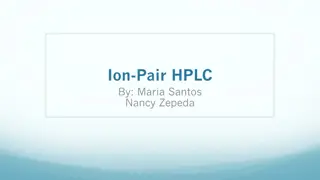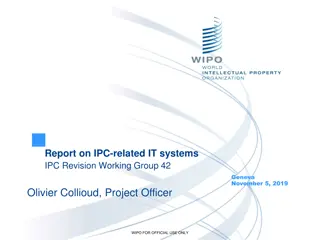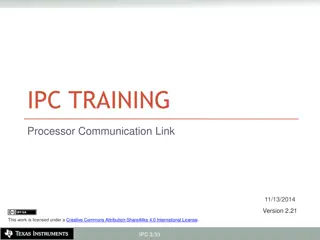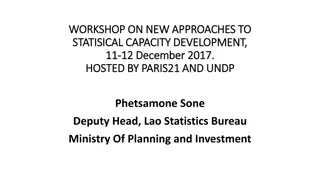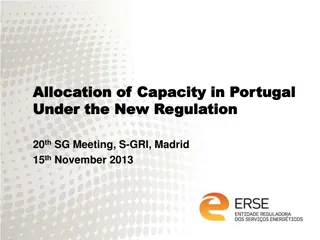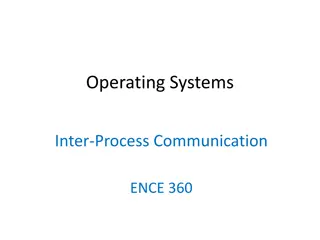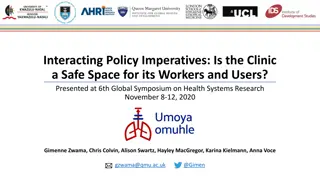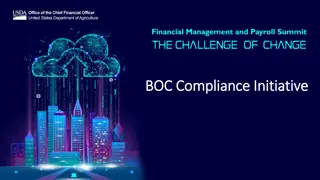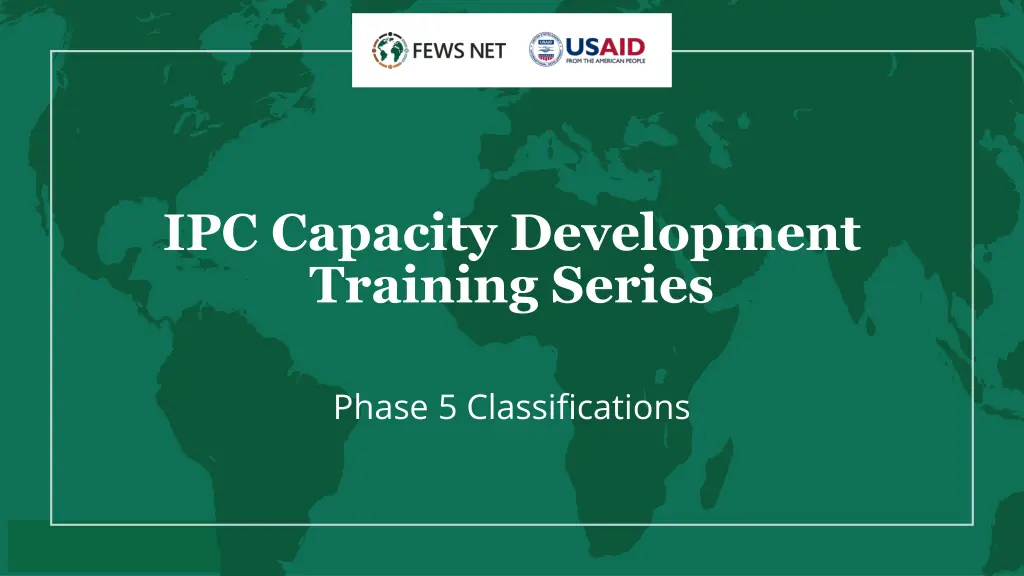
Understanding IPC Phase 5 Classifications for Famine Risk Assessment
Explore key definitions and classifications of IPC Phase 5 for household and area-level catastrophes, famine risk assessments, and detailed evidence requirements. Learn about the analytical process, review committee requirements, and more for effective classification analysis.
Download Presentation

Please find below an Image/Link to download the presentation.
The content on the website is provided AS IS for your information and personal use only. It may not be sold, licensed, or shared on other websites without obtaining consent from the author. If you encounter any issues during the download, it is possible that the publisher has removed the file from their server.
You are allowed to download the files provided on this website for personal or commercial use, subject to the condition that they are used lawfully. All files are the property of their respective owners.
The content on the website is provided AS IS for your information and personal use only. It may not be sold, licensed, or shared on other websites without obtaining consent from the author.
E N D
Presentation Transcript
IPC Capacity Development Training Series Phase 5 Classifications 1
Key definitions Household-level classification of Catastrophe (IPC Phase 5) Area-level classification of Famine (IPC Phase 5) Area-level Risk 0f Famine (IPC Phase 5) Annex: Tips for conducting a strong analysis of IPC Phase 5 classifications Session Outline 2
1. Define the household-level classification of Catastrophe (IPC Phase 5) 2. Detail the evidence requirements for classifying households in Catastrophe (IPC Phase 5) 3. Define the area-level classification of Famine (IPC Phase 5) 4. Distinguish between Famine with solid evidence and Famine with reasonable evidence 5. Detail the evidence requirements for classifying Famine (IPC Phase 5) 6. Detail the Famine Review Committee requirements and processs 7. Define a risk of Famine (IPC Phase 5) 8. Detail the analytical prcoess for identifying a risk of Famine (IPC Phase 5) Module Objectives 3
Household versus area-level classification Area-level classification is based on the convergence of: Household-level classification is based on the convergence of: 20% rule: at least 20% of the population must be in that Phase or worse based on the household level classification Food consumption Livelihoods change Contextual/contributing factor information Food consumption Livelihoods change Acute malnutrition Mortality Contextual/contributing factor information 5
Household versus area-level classification classification Household classification Area 6
Household-level classification of Catastrophe (IPC Phase 5) 7
Catastrophe (IPC Phase 5) definition Catastrophe (IPC Phase 5) Household level classification Household has an extreme lack of food and/or other basic needs Household is still experiencing extreme hunger after fully employing all available coping strategies, and/or they have exhausted their coping capacity/no coping options are available 8
Catastrophe (IPC Phase 5) evidence requirements A household has an extreme lack of food and/or other basic needs even after the full employment of coping strategies Two food security outcome indicators with a threshold for Catastrophe: HHS and HEA OA. All evidence should be considered. Examples include: evidence dietary diversity and quantity are extremely low (deeper dive into HDDS and FCS); extreme coping is evident; and contributing factor information also points to an extreme food deprivation. Convergence of evidence at the household level is helpful to making an accurate classification. Because this is a household-level classification and not an area-level classification, there does not need to be evidence of a high prevalence of GAM or hunger-related mortality. However, should it be possible to understand nutritional status within the household presumed to be in Catastrophe, this could lend further evidence to the classification. 9
Area-level classification of Famine (IPC Phase 5) 10
Famine (IPC Phase 5) definition Famine (IPC Phase 5) Area-level classification At least 1 in 5 households (20 percent) have an extreme lack of food and/or other basic needs after full employment of coping strategies Starvation, death, and destitution are evident (GAM and mortality) 11
Famine (IPC Phase 5) evidence requirements At least 20 percent of households has an extreme lack of food and/or other basic needs even after the full employment of coping strategies All information contributing to household-level classification is used here to understand if applicable to at least 20% of the population Direct outcomes (HHS, HEA OA) and contributing factors point to extreme food deprivation, all understood through a convergence of evidence. Because this is an area-level classification, there does need to be evidence of a high prevalence of GAM and hunger-related mortality. Acute malnutrition: Global acute malnutrition (WHZ) 30% Mortality: Crude death rate 2 deaths/10,000 people/day Any unit of analysis can be classified in Famine as long as the population in the unit of analysis is at least 10,000 people. 12
Famine (IPC Phase 5) evidence requirements Famine (IPC Phase 5), with solid evidence Famine (IPC Phase 5), with reasonable evidence Reliable direct evidence for the three outcomes: Food consumption/livelihood change: At least 20% of households in Catastrophe Acute malnutrition: Global acute malnutrition (WHZ) 30% Mortality: Crude death rate 2 deaths/10,000 people/day Somewhat Reliable direct evidence for the two of the three outcomes: Food consumption/livelihood change: At least 20% of households in Catastrophe Acute malnutrition: Global acute malnutrition (WHZ) 30% Mortality: Crude death rate 2 deaths/10,000 people/day *Replaces previous Famine Likely classification 13
Classifying Famine in the current situation vs. projecting Famine in the future What is a Famine classification in the current situation? Famine (IPC Phase 5) is classified in the current situation when at least 20 percent of the population in a given area currently has an extreme lack of food, resulting in extremely critical levels of acute malnutrition ( 30 percent of children under five) and significant levels of mortality attributed to starvation or the interaction of malnutrition and disease ( 2 people per 10,000 dying per day). What is a Famine projection? Famine is projected in the future when available information and the likely evolution of events suggests that Famine (IPC Phase 5), as defined above, is likely to occur in the future. 14
Classifying Famine in the current situation vs. projecting Famine in the future Current situation Projection period Reliable direct evidence for the three outcomes Current situation has reliable direct evidence for the three outcomes (+) a strong analysis is conducted to show that the famine thresholds are likely be exceeded in the projection period. Current situation has somewhat reliable direct evidence for two of the three outcomes (+) a strong analysis is conducted to show that the famine thresholds are likely be exceeded in the projection period. Famine (IPC Phase 5), with solid evidence Somewhat Reliable direct evidence for the two of the three outcomes. Famine (IPC Phase 5), with reasonable evidence (+) strong analysis is conducted to show the famine threshold of the third indicator is likely met or surpassed. 15
The Famine Review Committee A Famine Review is mandatory for any Famine classification current or projection. The review focuses on the plausibility of the Famine classification. A Famine Review is activated by the Global Support Unit (GSU) at the request of the country-level Technical Working Group (TWG). First, a Famine Review preparation is led by the GSU with support of experts from IPC global partners. These individuals, who were not directly involved in the IPC analysis, conduct a preliminary review of the Famine classification to verify adherence to IPC protocols. The Famine Review Committee (FRC) is a ~5-person team of independent international food security and nutrition experts. They aim to validate (or disprove) the Famine classification. Famine Reviews are mandatory for both IPC analyses and IPC-compatible analyses. The FRC review should be conducted before the release of the analysis. The conclusions and recommendations from the FRC are communicated to the country-level TWG and the IPC Global Steering Committee. The FRC produces a report summarizing their findings, that it is made publicly available on the IPC s website. 16
Area-level Risk 0f Famine (IPC Phase 5) 17
Risk of Famine (IPC Phase 5) definition Risk of Famine (IPC Phase 5) Area-level assessment This is not an IPC Phase classification, rather it describes the potential for an IPC classification (Famine) to occur in an alternative scenario. 18
IPC Guidance on risk of Famine (IPC Phase 5) The IPC recognizes that situations may exist where there is reasonable concern Famine could occur, but it is not the most likely scenario. The IPC determined that a risk of Famine should be used to identify areas that are in danger of experience Famine, although Famine is not projected to be the most likely scenario. Defines risk of Famine as the worst-case scenario with a reasonable probability of occurrence. While it is possible that multiple risk of Famine scenarios exist, the IPC advises only one (the worst-case) scenario be highlighted in the analysis brief (other scenarios can be included in the annex). The IPC advises that a mapping symbol for risk of Famine should be included in the IPC projection map. 19
FEWS NET guidance on risk of Famine (IPC Phase 5) A risk of Famine (IPC Phase 5) is communicating the potential for an IPC classification (Famine) to occur in a credible alternative scenario. Credible alternative scenarios are not the most likely scenario. These scenarios are based on credible events, with a moderate likelihood of occurrence. When the outcome of that credible alternative scenario is Famine (IPC Phase 5), FEWS NET identifies that the country faces a risk of Famine (IPC Phase 5). Famine would be classified 20
Risk of Famine (IPC Phase 5) Key differences between FEWS NET and the IPC s guidance FEWS NET does not refer to a worst-case scenario when describing a risk of Famine (IPC Phase 5). FEWS NET considers the connotation of worst-case scenario contradictory to the goal of defining a credible scenario. There can be multiple risk of Famine scenarios, and FEWS NET believes all should be equally communicated. FEWS NET does not map the risk of Famine on its acute food insecurity maps, based on the IPC manual s protocol that alternative classification maps should not be produced. It therefore does, in FEWS NET s opinion, go against the intention of protocols to not mapping alternative scenarios. It is the IPC s assessment that worst-case scenario' provides a clear reference point to analysts in terms of comparison to the 'most- likely scenario' that is used for the projection analysis. The IPC assesses that communication of multiple scenarios is likely to be confusing to decision- makers; feedback on doing so was not positive. The risk of Famine is not a classification but a statement. Therefore, highlighting the presence of this risk on the IPC map with a symbol does not, in the IPC s opinion, violate the IPC mapping protocols. 21
Annex: Tips for conducting a strong analysis of IPC Phase 5 classifications 22
Convergence of evidence approach Outcome indicators Contextual information Recent, previous, or anticipated shocks Impacts on food & income sources Supporting information on food consumption gaps and livelihoods coping Supporting data and observations of the physiological impacts of hunger Role of humanitarian assistance Food consumption Livelihoods coping Acute malnutrition levels Mortality levels Don t expect clear convergence use expert judgment to interpret the indicator outputs, local context, and historical trends before assessing your observations against the globally comparable characteristics of each IPC phase 23
Understand vulnerability to and severity of shock(s) Identify the shock(s) affecting the area Single shock Compounding shocks Idiosyncratic shocks What share of the population did the shock affect? Area-wide (at least 1 in 5 households) vs specific localities or population groups Can community leaders comment on if some, many, or most households are affected? Timing and duration Sudden vs. slow onset New vs. recurrent vs. prolonged Comparison to previous shocks If a historical record and/or analog years are available, how does the severity of the shock compare to past events? How do the affected people describe the severity of the shock in their historical memory? Comparability of shock(s) in other areas that have similar livelihood systems 24
Understand impacts on food & income sources Scale of food and income losses due to shock Did the shock negatively affect food/income sources? How many sources were affected? What sources is the population primarily relying on? How much lower are food/income sources compared to what is normal at this time of year (crops, livestock, fish, on- or off-farm labor, etc.)? If purchase-dependent, how many days of food can purchase weekly vs monthly? How does this compare to normal? Can atypical sources of food/income be accessed or not? Can these be expanded? Has a prolonged shock (especially in the case of conflict) substantially altered the availability of livelihood activities and coping options compared to the last baseline? Restricted population, commercial, humanitarian movements Can people leave the area and move to a location where food/income is available? Can traders deliver supplies and sell in the area? What risks do they face in doing so? Are markets functioning? Are there supply shortages? Is there still demand for/are people able to purchase their goods? Are humanitarians able to access the area? If not, how long has/will aid been suspended? 25
Understand the size of food consumption gaps Dietary quality To what extent has their diet changed in terms of the types of food consumed? Are less preferred substitutes still available (own-produced or purchased)? Dietary quantity How frequently are households going full days without eating on a weekly vs. monthly basis? Are children unable to sleep because they are hungry? Severe food-based coping strategies Is reliance on wild foods for consumption much higher than normal? To what extent is wild food consumption mitigating hunger? Are adults or children eating wild foods that makes them sick? Are people resorting to eating items typically considered unsanitary, taboo, unsafe, etc.? Other descriptions of hunger Are people unable to do their normal activities because they are hungry? How are people describing their level of hunger compared to past hunger periods? Are people having to choose between their most basic needs due to scarcity of options, e.g., collect water vs. find food vs. seek shelter/protection/physical safety? 26
Understand the exhaustion of coping capacity Less severe strategies: What less severe coping strategies have people already exhausted? For how long have they been unable to engage in them? Social support mechanisms: Are typical social support mechanisms exhausted? Are middle and better-off community members also selling off their assets and moving into lower wealth groups? Asset liquidation: What levels of asset liquidation and destitution are observed? Are people selling valuables, productive items, etc. that are understood to be a last resort? Are households abandoning or giving away their livestock because they are unable to feed/water them? Migration: Are some members of the household leaving/migrating and sending food/money back to the rest of the house? Or are whole households displacing in search of food aid? Are villages abandoned except for those who are to unable to physically travel long distance/pay for transport? Begging: To what extent are people begging for food or money to buy food from religious institutions, strangers within the same town, or traveling to beg for food in other villages/towns? Illicit activities, such as theft: To what extent is this occurring due to erosion of rule of law or desire for retaliation or some other reason than the risk of starvation? Physical safety: Are people risking their physical safety in order to access food to survive? 27
Understand the role of humanitarian assistance What relative share of total food do households estimate they received from humanitarian assistance (in- kind or cash) over the past 1, 2, or 3 months? Is it their most important (or second, or third) source of food? Are households selling or bartering aid in order to obtain other essential or non-essential goods, services? Are there barriers preventing households from accessing food distribution points? Physical safety and protection concerns Gatekeeping by community leaders or other authority figures Are certain marginalized groups unable to access/receive aid Ultimately, if humanitarian food assistance is currently ongoing or planned: If the evidence suggests food consumption gap remain severe among the population, it is important to investigate: Are at least 1 in 5 households in the area unable to receive it (and why)? Is the amount (ration size, whether in-kind or cash transfer equivalent) is insufficient? 28
Understand the physiological impacts of hunger Other means of assessing atypically very high levels of acute malnutrition If acute food insecurity survey data collection occurred, what did the enumerators witness? If interviewing key informants or conducting a field assessment, look for and ask about: Visible signs of wasting among children Visible signs of wasting among pregnant/lactating mothers and other adults Surge in admissions of malnourished children compared to past admissions trends Seek out worst-affected households to interview Corroborate the experience of the physical impacts Do adults lack the energy/are they too tired to engage in physical activities due to a lack of food? Do they have difficulty concentrating and/or completing basic tasks they typically do? Are children too hungry and tired to attend school or play due to a lack of food? Information on excess mortality Are there atypical cases of hunger-related mortality reported by local authorities, health workers, or community members? Concurrent disease outbreaks Are any outbreaks/epidemics exacerbating the impacts of hunger on people s health? 29


